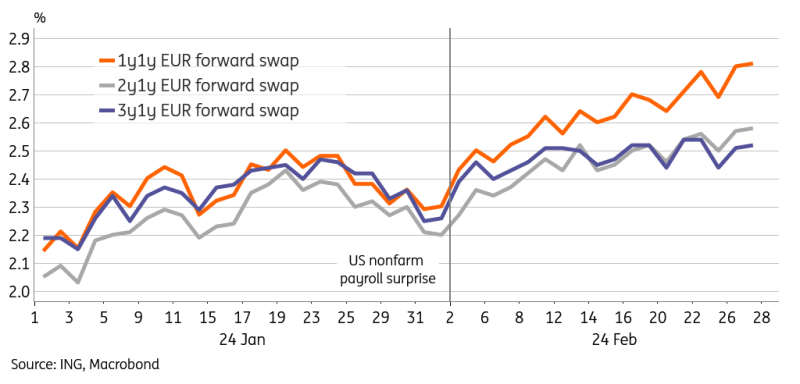By Benjamin Schroeder
Rates are still looking to go higher near term. While supply has helped over the past few days, rates remain sensitive to the data. So far, pushing back the expectations for the start of the easing cycles has had less impact on prospective landing levels. The risk of something breaking due to higher-for-longer policy rates is a secondary thought, for now
Rates Are Still Looking to Go Higher Near Term
Rates are still looking to go higher. Despite a stronger start into yesterday’s session, the bearish sentiment prevailed by the end of the day with eurozone bond markets also having to digest sizeable long-end supply, foremost a new 30Y French benchmark – this time the curve resteepened from the long end.
Yet, the overall driver remains the macro backdrop and with it, the assessment of policy paths, foremost of the Federal Reserve. The market is still sensitive to the data as witnessed by yesterday’s reaction to the durable goods orders, or more precisely the stronger capital goods shipments which enter GDP calculations. But the market also appears somewhat selective. A notable decline in the Conference Board’s consumer confidence left rates unfazed. But we have reached one bearish milestone. With the repricing of the front end, the market is now aligned with the Fed’s median dot plot showing three 25bp cuts this year.
For Now, Pushing Back First Rate Cuts has Had Less Impact on the Expected Landing
Euro rates have joined the pushback of rate cuts in US markets, but the landing zone has remained relatively unchanged. Forward curves now price in 100bp of rate cuts in 2024, compared to almost 150bp a month ago. At the same time, 1y1y forwards joined the trend upwards, indicating that in 2025, the policy rate is also expected to remain higher (see chart below). But when looking ahead at 2026 and beyond – as captured by the 2y1y and 3y1y forwards – we note that those points remain relatively anchored. This divergence suggests that recent rate moves were driven predominantly by a change in the timing of cuts and less so by a conviction that the endpoint is higher.
The picture is similar, though not quite as pronounced, in the US as the market did tilt more towards a soft landing scenario, and the data surprises to the upside appear to corroborate this view. But at some point, with higher rates for longer, the risk of a hard landing further down the line should increase. The overall economy has so far shown resilience despite a tightening of monetary policy, but in the end, only one pillar needs to break to drag the rest down. An obvious candidate in the US is the commercial real estate sector, but also steep delinquencies and rising credit card rates cannot be ignored. As long as policy rates remain restrictive, the buildup in such pockets of risk will keep increasing.
For now, the market has put hard landing risks on the back burner in Europe and obviously, the US, which has also prevented a deeper inversion of curves. Despite potentially higher hard landing risks in the future, we expect markets to maintain a bearish bias towards bonds in the immediate near term.
EUR Forwards Show More Rate Cuts Pushed Towards 2025
Today’s Events and Market View
The data calendar for this session is rather calm with mortgage applications and the US fourth-quarter GDP revisions of note. For the latter, the market is only looking for a slight downward revision in the personal consumption component, but the 3.3% quarter-on-quarter should stand. Also speaking to the momentum of the US economy, the Atlanta Fed GDP tracker for the first quarter rose to 3.25% with yesterday’s update. The eurozone will see the release of European Commission sentiment indicators.
In eurozone primary markets, Germany sells 14Y and 18Y Bunds for a total of €1.5bn. Italy will auction new 5Y and new 10Y bonds today alongside tapping a floating rate note – for up to €9.75bn overall. Note that Italy is also selling a BTP Valore retail bond. The sale ends on Friday with around €11bn in orders in the book for the first two days. This points to another sizeable retail sale which, in turn, lessens the pressure on market funding supporting the currently tighter market spreads for Italian government bonds. Outside the eurozone, the UK sells a new 7y Gilt for £4bn.
Disclaimer: This publication has been prepared by ING solely for information purposes irrespective of a particular user’s means, financial situation or investment objectives. The information does not constitute investment recommendation, and nor is it investment, legal or tax advice or an offer or solicitation to purchase or sell any financial instrument. Read more


